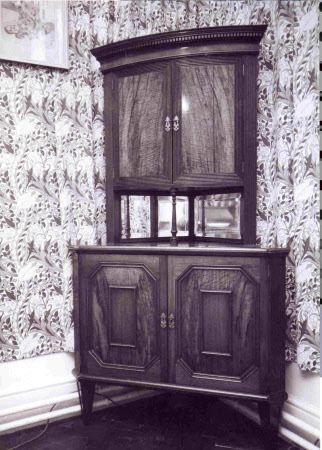Corner cupboard
Agnes Garrett (1845 - 1935)
Category
Furniture
Date
circa 1880
Materials
Walnut, mirror glass, brass escutcheons
Measurements
158 x 87.5 x 62.5 cm
Order this imageCollection
Standen House and Garden, West Sussex
NT 1213990
Caption
The cousins Agnes and Rhoda Garrett opened their interior decoration business from their London flat in the early 1870s. In doing so, they disrupted the field completely. Before the Garretts, interior decoration was a male-dominated business. Men designed and supplied wallpaper, furniture and textiles for the home. Women, put simply, did not. The cousins were active suffrage campaigners and were passionate about improving the lives of fellow women. By carefully manipulating the well-established connection between the home, femininity and domesticity, they were able to position interior decoration as a new field of employment eminently suitable for women. But earning the sobriquet of Britain’s first women interior decorators was no mean feat, and the cousins struggled to find a firm willing to offer them professional training. Fortunately, the Garretts were well-connected and cleverly exploited their network to build a clientele. Their work was well covered by the press, with celebrity clients including Hubert and Maude Parry, Lord Kelvin, Catherine Buckton, Ada Wellesley and Lady Dorothy Nevill. Unfortunately, interior decoration is ephemeral and little evidence of these commissions survives. The collection at Standen of several pieces of Garrett furniture, probably one of their earliest commissions, is a remarkable exception. With their gracefully tapered legs and subtle historic references, the pieces showcase the cousins’ signature Queen Anne style. Several were featured in the Garretts’ 1876 book Suggestions for House Decoration. Aimed at the metropolitan middle classes, the manual offered advice on how to decorate tastefully on a limited budget, and firmly established the Garretts as tastemakers and experts. Although Rhoda died young in 1882, Agnes continued in business until 1905. In doing so, she paved the way for future generations of women to make their mark on interiors around the UK.
Summary
A figured walnut freestanding corner cupboard, English, designed by Rhoda and Agnes Garrett, circa 1880. The bowfront upper section with dentil-moulded cornice and a pair of cupboard doors within a reeded frame, shelves within and bevelled mirror-back recess below, the lower section crossbanded on the top surface and enclosed by a pair of doors, shelves within, each door applied with an octagonal panel surrounding a smaller rectangular panel and flanked by reeded angles, standing on square tapering panelled legs.
Full description
Cousins Rhoda (1841-1882) and Agnes Garrett (1845-1935) trained in the architectural office of J.M. Brydon before setting up their own interior design company in 1875 which aimed to bring fresh designs to a wider middle-class public. Together they wrote and published 'Suggestions for House Decoration in Painting, Woodwork and Furniture' in 1876, part of the 'Art at Home' series of interior decoration and household taste manuals published by Macmillan. They also decorated 4, Upper Berkeley Street, the home of Agnes's sister, Elizabeth Garrett Anderson, the first English woman permitted to qualify as a doctor.See 'Suggestions for House Decoration' where this cabinet is illustrated facing page 62.
Makers and roles
Agnes Garrett (1845 - 1935), designer Rhoda Garrett (1841 - 1882), designer
References
Garrett, Rhoda & Agnes, Suggestions for house decoration in painting, woodwork, and furniture., 1876, p.62 Conroy, Rachel, Women Artists and Designers at the National Trust, 2025, pp. 130-133


